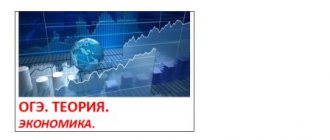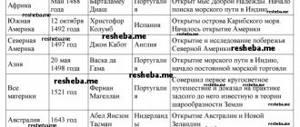Presentation on economics on the topic: “Supply and Demand” (grade 10)
FGKOU NSVU Ministry of Internal Affairs of Russia
Cycle of humanitarian and mathematical disciplines
DEMAND and
OFFER
Prepared by an economics teacher
Filippova Oksana Yurievna
Thomas Robert Malthus
Adam Smith
“Even a very poor person may, in a certain sense of the word, have a demand for a carriage drawn by six horses; he may even desire to have her; but his demand will never become a real demand, since this product will never come to market to satisfy the desires of this particular person."
The quantity demanded
is
the volume of a product of a certain type (in physical measurement) that buyers are ready (willing and able) to purchase over a certain period of time (month, year) at a certain price level for this product.
Demand curve
describes the picture of demand in a given product market, i.e. dependency between:
- price of the goods and
- volumes of his purchases possible at different price levels.
The demand curve
allows you to answer 2 questions:
- what will be the quantity demanded at different price levels;
- How will the quantity demanded change with some change in price?
Demand
is
_
the dependence of the magnitude of demand in a given product market on the prices at which goods can be offered for sale that has developed over a certain period of time.
Question
How many goods will buyers be willing to purchase per month at a price of 100 rubles?
The answer will be information about the AMOUNT OF DEMAND.
How many goods will the buyers be willing to purchase in a month at different price levels for this product?
The answer will be the DEMAND
on the market for this product.
Law of Demand
An increase in prices usually leads to a decrease in the quantity demanded, and a decrease in prices usually leads to an increase.
In addition to the price of the product itself, the formation of demand is influenced by:
- Prices of other goods;
- Buyers' income level;
- Number of buyers;
- Customer preferences (formed under the influence of their tastes, traditions, advertising, and other circumstances).
Price
Supply curve
Product
The supply curve
allows you to answer 2 questions:
- what will be the quantity supplied at different price levels;
- how the quantity supplied will change with some change in price.
The proposal
is
the dependence of supply values on the market for a certain product during a certain period of time (month, year) that has developed over a certain period of time on the price levels at which this product can be sold.
Law of supply
An increase in prices usually leads to an increase in the quantity supplied, and a decrease in prices usually leads to a decrease in supply.
Problem 1
As a result of the advertising campaign, the population began to prefer Coca-Cola to kvass. What will happen to the demand curve for kvass?
Problem 2
As a result of the advertising campaign, the population began to prefer Coca-Cola to kvass. What will happen to the demand curve for Coca-Cola?
Problem 3
How will the demand for red caviar change with an increase in population income?
Problem 4
What will happen to the demand curve for pearl barley as consumer income increases?
Problem 5
What will happen to the demand for salt as household incomes increase?
What can shift the demand curve for salt?
Homework
Find information about interchangeable goods (substitutes) and complementary goods (complements).
Give examples.
Presentation for the social studies lesson “Market Economics”
How can you describe in one word what you see on the screen? (slide)
- Product
—Are computer services, for example, a product?
- Yes. Why?
Definition in a notebook: A product is any thing that participates in free exchange for other things, a product of labor that can satisfy human needs and is specially produced for exchange. Items produced for personal consumption are not goods in the economic sense.
— Where can I buy the product?
- On the market.
— What is the name of the type of market that determines prices, and sellers and buyers are forced to accept them:
1) competitive
2) imperfect 3) centralized 4) planned?
Why is it called that?
— Because the market is based on competition between producers.
So, today in class we will talk about the market economy, the market mechanism for regulating the economy.
What is a market? Let's try to define it.
- exchange of goods for banknotes or other goods
— interaction between producers and consumers
- dependence of production on consumer demand
Notebook definition: Market
- this is an exchange organized according to the laws of commodity production and circulation, a set of commodity exchange relations; a mechanism for interaction between producers and consumers, in which producers of goods, focusing on customer demand, decide for themselves when, in what quantity and what goods to produce. (slide)
The characteristic features of a market economy are: free exchange, private property and
financial responsibility for the results of decisions made.
(slide) For normal activity, the market needs: free pricing, competition, freedom of entrepreneurial activity. (slide)
For the market to function properly, competition is required.
Competition
is rivalry between producers.
We read the paragraph competition on pp. 168-169 and try to answer the question: What are the advantages of competition?
This is the engine of trade.
Participants in the competitive struggle are faced with a choice: either at the cost of enormous efforts to “fit in” with progress and identify those who have achieved success, or to accept the loss of profit.
Competition makes it possible to do without public control of production and gives the manufacturer the opportunity to make economic decisions himself.
In your notebook: The advantages of competition: lower prices, improved quality of goods, development of new technologies, progress. (slide)
Why do you think, if competition makes it possible to do without social control of production, then why doesn’t anarchy and disorder reign in the economy? (Producers submit to price dictatorship)
In order to understand how the market price is created and how it helps coordinate the behavior of market participants, it is necessary to become familiar with the concepts of “demand” and “supply”.
What do you think supply and demand are? What definitions are given in textbooks? Write them down in your notebook.
Demand is the consumer’s desire and ability to buy a specific product or receive a service at a specific time and in a specific place.
Offer is the desire and ability of the seller to sell a specific product at a specific time and place. (slide)
Demand directly depends on price. What else affects demand (slide)
Indicate the season in which each of the services and goods presented will be in great demand and why?
We see that demand is influenced by seasonality
Another example of the dependence of demand on non-price factors (slide)
What will happen to the demand for soda if packaged juice becomes cheaper? This is an example of a change in demand depending on the availability of a substitute product.
What other substitute products do you know?
So, the amount of demand depends not only on price, but also on the season, customer preferences, fashion, etc.
In your notebook: The law of demand - the higher the price, the less demand.
What factors influence supply? We independently look for it in the textbook and write it down in a notebook:
Price, increase or decrease in production costs, employee wages, raw material costs, use of efficient technologies
Another condition for the functioning of the market is free pricing. Prices serve two main functions.
Price functions
Limit consumption
Resources
Motivation for production
The most difficult work of leveling prices, invisible to the eye, takes place on the market. How does this happen?
For example, they sell greens at the market - for some a bunch of parsley costs 10 rubles, for others - 30 rubles (but it is fresh). What price can be set to sell all the greens?
This is the equilibrium price - the price that balances supply and demand as a result of competition.
So, what is the main principle of the market? The transaction must be beneficial to both the seller and the buyer.
You all have been to markets. Do you remember if you haggled over prices? If so, what was the outcome and how did it happen? If not, then why - were they embarrassed, did not know how, considered it beneath their dignity, or was there no need?
What is the impact of the market on various aspects of society?
Conclusion: the market is one of the effective ways to regulate the economic life of society.
Offer. Supply curve. Law of supply. - presentation
2. Offer. Supply curve. Law of supply. Market functioning mechanism PZ-6
Supply SUPPLY is the quantity (volume) of goods offered for sale on the market at a certain moment or period. In value terms, supply represents the sum of the market prices of these goods. The main factors of supply are the price of the good and non-price factors (factors other than prices that influence the supply and demand of goods on the market). Non-price factors include the income of buyers, production costs of goods, fashion, the provision of subsidies, the presence of complementary and interchangeable goods on the market, inventories and a number of other factors, including those of a psychological nature. The offer price is the minimum price at which the seller agrees to sell a certain quantity of a given good. The relationship between the price of a good and the volume of its supply is reflected in the law of supply.
Supply curve The supply curve is a curve that shows how much of an economic good, other conditions being constant, producers are willing to sell at different prices in a given period of time. The supply curve is an expression of the relationship between the price of a good in the market and the volume of goods supplied by sellers on the graph. In most cases, the supply curve is “upward” or “concave.”
The main elements on which the supply curve is based are: Costs of production, represented by the price of resources and technological progress; Production technologies, if they are improved, then production costs are reduced, the output of goods increases, and supply increases accordingly; Prices for resources; The prices of substitute goods, since they are products of the same production process, means that if the price of one increases, the price of the second will increase; The number of producers, their increase implies a larger volume of supply; Number of consumers; Government taxes and subsidies. When tax rates increase, production volumes decrease, and when subsidies are available, production expands; Government policy assumes that by eliminating quotas and customs duties on imports, the supply of goods will increase; Special factors, such as natural conditions.
Changing the supply curve Supply will change if at least one of the factors that influence it changes, not including the price of the good. 1. Movement along the supply curve means the reaction of producers to a change in the price of a good, other things being equal, and also reflects a change in the volume that producers are able to sell. This movement along the supply curve suggests that when the volume of goods changes, if none of the factors that influence the curve changes, the price of the good changes. 2. A shift in the supply curve shows the response of producers to changes in non-price factors and reflects a change in supply. A change in supply means that the volume of goods that producers are able to sell changes. If the curve shifts to the right, this indicates an expansion in the supply of the good, and if it shifts to the left, it means that supply is decreasing.
What is the supply curve? The factor of time, the period during which producers can adjust output depending on changes in price, is important for the elasticity of the supply curve. 1. In the instantaneous period when a good is produced and is on the market, supply may be completely inelastic. If the price continues to rise, the supply curve will become vertical.
2. In the case when the good has not yet been produced, and only producers decide how much to produce, they act in a short period. The supply curve changes shape depending on the minimum prices at which producers want to produce products. Supply will be highly elastic when producers can increase production without increasing costs.
3. In the case of equal minimum prices for the benefit of all producers, the minimum volume of supply on the market will be large. Producers will enter the market if the price rises to the Pmin value and the supply volume jumps from zero to the Qmin value. Conversely, if the price falls below the Pmin level, then all producers will leave the market and the supply volume will drop to zero.
Law of Supply Essentially, the law of supply says that at high prices, more goods are supplied than at low prices. If we imagine supply as a function of price and the quantity of goods supplied, the law of supply characterizes the increase in the supply function throughout the entire domain of definition. The law of supply states: The quantity supplied of a product on the market increases with its price, all other things being equal (production costs, inflation expectations, quality of the product).
What explains the law of supply? To answer this question, that is, to justify the reliability of the law of supply, we can put forward the following arguments: When the price of a product rises, producers interested in increasing profits will begin to expand their production. In addition, entrepreneurs from other industries will flock to the industry where prices are rising, withdrawing their capital from less profitable businesses. The opening of new enterprises will further increase the volume of supply. An increase in the volume of supply is associated with an increase in the price of a product also because the production of each additional unit of a product requires additional costs. Therefore, additional output will be produced if the price of the product increases. The expansion of production can continue until the additional costs exceed the additional income received from producing one more additional unit of output. Until now, we have been talking about changing the quantity of supply, i.e., the quantity of a product that producers intend and can produce at a certain price for this product. This suggests that the quantity supplied is primarily a function of the price of the product: Qs = ƒ(P). But in real life, supply changes not only under the influence of changes in the price of the goods produced. There are a number of factors that cause an increase or decrease in supply that are not related to changes in the price of a given product. Let's look at them.
Non-price supply factors NON-PRICE SUPPLY FACTORS are factors that influence the quantity of supply and are not related to the price of the product. When non-price factors change, the supply quantity changes at given price values; thus changing the supply curve. In this case, we usually talk about a shift in the supply curve. When supply increases, the curve shifts to the right; when supply decreases, it shifts to the left.
1. Prices of resources used in the production of goods. The more an entrepreneur must pay for labor, land, raw materials, energy, etc., the lower his profit and the less his desire to offer this product for sale. 2. Level of technology. Any technological improvement, as a rule, leads to a reduction in resource costs and is therefore accompanied by an expansion in the supply of goods. 3. Goals of the company. The main goal of any company is to maximize profits. However, firms may often pursue other goals, which affects supply. 4. Taxes and subsidies. Taxes affect the expenses of entrepreneurs. An increase in taxes means for a company an increase in production costs, and this, as a rule, causes a reduction in supply; Reducing the tax burden usually has the opposite effect.
5. Prices for other goods can also affect the supply of a given good. For example, a sharp increase in oil prices can lead to an increase in the supply of coal. 6. Manufacturers' expectations. Thus, producers' expectations of a possible price increase have an ambiguous effect on the supply of goods. Supply is closely related to investments, and the latter react sensitively and, most importantly, difficultly predictably to market conditions. 7. Number of manufacturers
Conclusions: Supply is the quantity of goods offered by the manufacturer for sale on the market. The direct relationship between price and quantity of a product offered is the law of supply. The supply curve is the relationship between market prices and the quantity of products that producers are willing to produce and sell. Non-price supply factors are factors that influence the quantity of supply and are not related to the price of the product.
Related questions: How do taxes and subsidies affect supply? What is a supply curve? Name the main supply factors. What principle is the law of supply based on? What do movements along the supply curve and a shift in the supply curve indicate?






